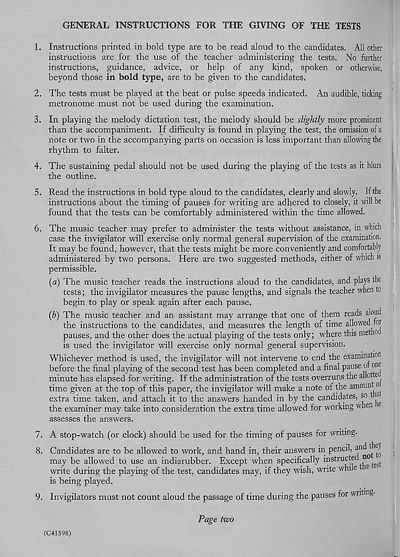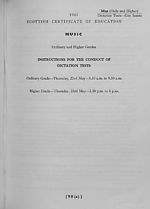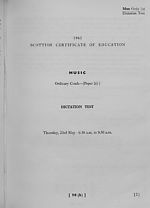Download files
Complete book:
Individual page:
Thumbnail gallery: Grid view | List view

GENERAL INSTRUCTIONS FOR THE GIVING OF THE TESTS
1. Instructions printed in bold type are to be read aloud to the candidates. All other
instructions are for the use of the teacher administering the tests. No further
instructions, guidance, advice, or help of any kind, spoken or otherwise,
beyond those in bold type, are to be given to the candidates.
2. The tests must be played at the beat or pulse speeds indicated. An audible, ticking
metronome must not be used during the examination.
3. In playing the melody dictation test, the melody should be slightly more prominent
than the accompaniment. If difficulty is found in playing the test, the omission of a
note or two in the accompanying parts on occasion is less important than allowing the
rhythm to falter.
4. The sustaining pedal should not be used during the playing of the tests as it blurs
the outline.
5. Read the instructions in bold type aloud to the candidates, clearly and slowly. If the
instructions about the timing of pauses for writing are adhered to closely, it will be
found that the tests can be comfortably administered within the time allowed.
6. The music teacher may prefer to administer the tests without assistance, in which
case the invigilator will exercise only normal general supervision of the examination.
It may be found, however, that the tests might be more conveniently and comfortably
administered by two persons. Here are two suggested methods, either of which is
permissible.
(a) The music teacher reads the instructions aloud to the candidates, and plays the
tests; the invigilator measures the pause lengths, and signals the teacher when to
begin to play or speak again after each pause.
(h) The music teacher and an assistant may arrange that one of them reads aloud
the instructions to the candidates, and measures the length of time allowed for
pauses, and the other does the actual playing of the tests only; where this metho
is used the invigilator will exercise only normal general supervision.
Whichever method is used, the invigilator will not intervene to end the examination
before the final playing of the second test has been completed and a final pause ot one
minute has elapsed for writing. If the administration of the tests overruns the allotte^
time given at the top of this paper, the invigilator will make a note of the amount o
extra time taken, and attach it to the answers handed in by the candidates, so t ^
the examiner may take into consideration the extra time allowed for working when
assesses the answers.
7. A stop-watch (or clock) should be used for the timing of pauses for writing.
8. Candidates are to be allowed to work, and hand in, their answers in pencil, and they
may be allowed to use an indiarubber. Except when specifically instructed n ^
write during the playing of the test, candidates may, if they wish, write while t e
is being played.
9. Invigilators must not count aloud the passage of time during the pauses for writing.
Page two
(C41S9S)
1. Instructions printed in bold type are to be read aloud to the candidates. All other
instructions are for the use of the teacher administering the tests. No further
instructions, guidance, advice, or help of any kind, spoken or otherwise,
beyond those in bold type, are to be given to the candidates.
2. The tests must be played at the beat or pulse speeds indicated. An audible, ticking
metronome must not be used during the examination.
3. In playing the melody dictation test, the melody should be slightly more prominent
than the accompaniment. If difficulty is found in playing the test, the omission of a
note or two in the accompanying parts on occasion is less important than allowing the
rhythm to falter.
4. The sustaining pedal should not be used during the playing of the tests as it blurs
the outline.
5. Read the instructions in bold type aloud to the candidates, clearly and slowly. If the
instructions about the timing of pauses for writing are adhered to closely, it will be
found that the tests can be comfortably administered within the time allowed.
6. The music teacher may prefer to administer the tests without assistance, in which
case the invigilator will exercise only normal general supervision of the examination.
It may be found, however, that the tests might be more conveniently and comfortably
administered by two persons. Here are two suggested methods, either of which is
permissible.
(a) The music teacher reads the instructions aloud to the candidates, and plays the
tests; the invigilator measures the pause lengths, and signals the teacher when to
begin to play or speak again after each pause.
(h) The music teacher and an assistant may arrange that one of them reads aloud
the instructions to the candidates, and measures the length of time allowed for
pauses, and the other does the actual playing of the tests only; where this metho
is used the invigilator will exercise only normal general supervision.
Whichever method is used, the invigilator will not intervene to end the examination
before the final playing of the second test has been completed and a final pause ot one
minute has elapsed for writing. If the administration of the tests overruns the allotte^
time given at the top of this paper, the invigilator will make a note of the amount o
extra time taken, and attach it to the answers handed in by the candidates, so t ^
the examiner may take into consideration the extra time allowed for working when
assesses the answers.
7. A stop-watch (or clock) should be used for the timing of pauses for writing.
8. Candidates are to be allowed to work, and hand in, their answers in pencil, and they
may be allowed to use an indiarubber. Except when specifically instructed n ^
write during the playing of the test, candidates may, if they wish, write while t e
is being played.
9. Invigilators must not count aloud the passage of time during the pauses for writing.
Page two
(C41S9S)
Set display mode to:
![]() Universal Viewer |
Universal Viewer | ![]() Mirador |
Large image | Transcription
Mirador |
Large image | Transcription
Images and transcriptions on this page, including medium image downloads, may be used under the Creative Commons Attribution 4.0 International Licence unless otherwise stated. ![]()
| Scottish school exams and circulars > Scottish Certificate of Education > 1963 > (352) |
|---|
| Permanent URL | https://digital.nls.uk/130803356 |
|---|
| Attribution and copyright: |
|
|---|---|
| Shelfmark | GEB.16 |
|---|---|
| Additional NLS resources: | |
| Description | Examination papers for the School Leaving Certificate 1888-1961 and the Scottish Certificate of Education 1962-1963. Produced by the Scotch (later 'Scottish') Education Department, these exam papers show how education developed in Scotland over this period, with a growing choice of subjects. Comparing them with current exam papers, there are obvious differences in the content and standards of the questions, and also in the layout and use of language |
|---|---|
| Additional NLS resources: |
|



